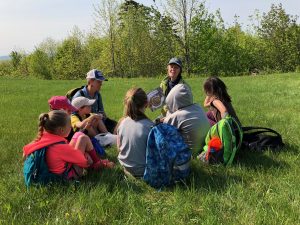 “Get up, it’s HOGBACK DAY! Let’s get out of here!” Deb Ayer’s daughter woke her up on the sunny morning of May 25, “like it was Christmas.” Once a year all the children and teachers of Marlboro Elementary School head for the hills to explore and enjoy Hogback Mountain. Everyone looks forward to the nature-based activities and picnic lunch on the Meadow ski slope. But what really makes the magic of Hogback Day sparkle are the special ways that children discover, imagine, create and connect with the gifts of nature.
“Get up, it’s HOGBACK DAY! Let’s get out of here!” Deb Ayer’s daughter woke her up on the sunny morning of May 25, “like it was Christmas.” Once a year all the children and teachers of Marlboro Elementary School head for the hills to explore and enjoy Hogback Mountain. Everyone looks forward to the nature-based activities and picnic lunch on the Meadow ski slope. But what really makes the magic of Hogback Day sparkle are the special ways that children discover, imagine, create and connect with the gifts of nature.
DISCOVER… ice and porcupines
 Adventures on Hogback Day take many forms, including the challenge of George Leoniak’s Animal Rambles: “How many tracks and signs of different animals can we find at Hogback Mountain?” Nancy Anderson, Hogback day volunteer and enthusiast, reported: “The kids in George’s group… went off into the woods and found ice in a cave about 4′ deep… and a spruce tree that had bark strips removed by a porcupine.” George reflected, “It made me happy to just be there seeing the kids so excited.”
Adventures on Hogback Day take many forms, including the challenge of George Leoniak’s Animal Rambles: “How many tracks and signs of different animals can we find at Hogback Mountain?” Nancy Anderson, Hogback day volunteer and enthusiast, reported: “The kids in George’s group… went off into the woods and found ice in a cave about 4′ deep… and a spruce tree that had bark strips removed by a porcupine.” George reflected, “It made me happy to just be there seeing the kids so excited.”
IMAGINE… you are tiny as an insect
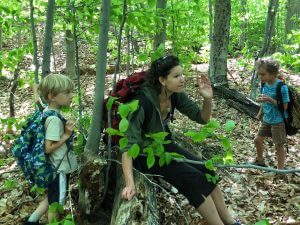 Three morning activities highlighted what Rachel Carson described as, “children’s delight in the small and inconspicuous.” In Storybook Mountain, Lauren MacArthur invited children to imagine themselves as tiny characters, inspired by a quotation from Henry David Thoreau: “Nature will bear the closest inspection. She invites us to lay our eye level with her smallest leaf, and take an insect view of its plain.”
Three morning activities highlighted what Rachel Carson described as, “children’s delight in the small and inconspicuous.” In Storybook Mountain, Lauren MacArthur invited children to imagine themselves as tiny characters, inspired by a quotation from Henry David Thoreau: “Nature will bear the closest inspection. She invites us to lay our eye level with her smallest leaf, and take an insect view of its plain.”
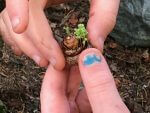
Vigorously stirring a green concoction with a teeny twig spoon, two girls exclaimed, “we’re making fairy soup!” Children creating Little People Houses with Nancie Schwartz-Angell immersed themselves in decorating magical tiny worlds with splendid details of pine needle entryways, bluet chandeliers and acorn mixing bowls.
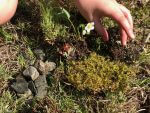 Jane Jone’s Magical Miniature Terrariums offered children an opportunity to design intricate tiny worlds from foraged mosses, dirt, rocks and plants. As children shared stories of the worlds they had created, one student referred to a cactus garden in Washington, D.C., while another said, “it’s called moss land because it’s really mossy.”
Jane Jone’s Magical Miniature Terrariums offered children an opportunity to design intricate tiny worlds from foraged mosses, dirt, rocks and plants. As children shared stories of the worlds they had created, one student referred to a cactus garden in Washington, D.C., while another said, “it’s called moss land because it’s really mossy.”
CREATE … something inspired by nature
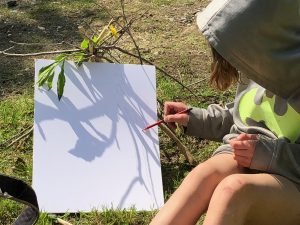 Art from Nature, led by Patti Smith from Bonnyvale Environmental Education Center, invited children to create art inspired by nature. Images of Andy Goldsworthy’s artwork captivated children’s attention, catalyzing their creations of sculptures, drawings and paintings incorporating mud, twigs, leaves and acorns. When asked to display his mud painting, one boy turned the ephemeral artwork into a live performance: “I’m going to do something funny and lie down next to my painting.”
Art from Nature, led by Patti Smith from Bonnyvale Environmental Education Center, invited children to create art inspired by nature. Images of Andy Goldsworthy’s artwork captivated children’s attention, catalyzing their creations of sculptures, drawings and paintings incorporating mud, twigs, leaves and acorns. When asked to display his mud painting, one boy turned the ephemeral artwork into a live performance: “I’m going to do something funny and lie down next to my painting.”
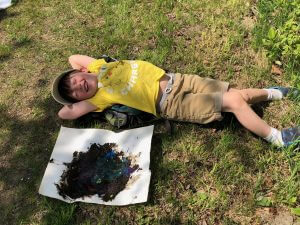
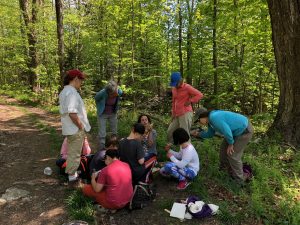 Four Marlboro College professors, Carol Osman, Cathy Hendrickson, Jenny Ramstetter and Jamie Tanner, integrated artwork, measurement and writing into their activity Observations from Nature. Halfway up the mountain, Jaime Tanner spread out her collection of animal skulls and invited children to “pick a skull, any skull” and learn about the animal by sketching, measuring and trying to identify the creature.
Four Marlboro College professors, Carol Osman, Cathy Hendrickson, Jenny Ramstetter and Jamie Tanner, integrated artwork, measurement and writing into their activity Observations from Nature. Halfway up the mountain, Jaime Tanner spread out her collection of animal skulls and invited children to “pick a skull, any skull” and learn about the animal by sketching, measuring and trying to identify the creature.
CONNECT… with the magic of Hogback’s gifts
Everyone creates their own kinds of connections on Hogback Day: connecting flying discs to baskets; saplings to furniture; tracks to porcupines; and shadows to paintings. At the heart of all these connections is a sense of kinship with nature, beautifully expressed by Milo MacArthur in his poem, Magical Water. Milo’s perspective on exchanging gifts with nature captures the magic of the day and serves as a vivid reminder to respond to the wake-up call: “Get up, it’s HOGBACK DAY!

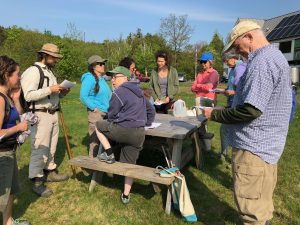
Thank you!
Thank you to all the people who make Hogback Day possible: Rochelle and Erica for taking the lead on organizing the event; Hogback Mountain Conservation Association for saving the forest and supporting the annual event with facilitator stipends and volunteer helpers; and all the group activity facilitators for sharing their love of nature with the students of Marlboro Elementary School.
Written by Carol Berner
HMCA Board member & Regional Coordinator of River of Words.
Hogback Mountain Conservation Area is the headwaters of the Rock River, Upper Green River, and North Branch of the Deerfield River watersheds.







